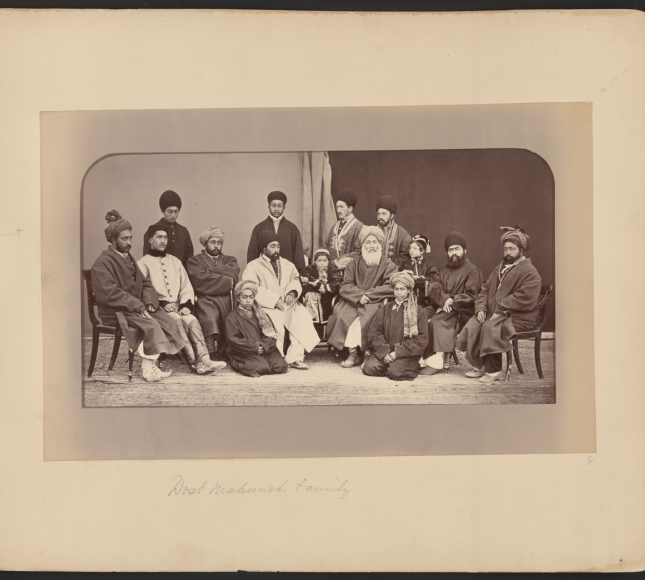DOST MUHAMMAD KHAN. AMIR (1791-1863), ruler of Kabul and Qandahar, was the son of Painda Khan (executed 1799), the Barakzai chief. Dost Muhammad`s first engagement with the Sikhs was at Attock, the Afghan citadel, which had fallen into the hands of the Sikhs in June 1813. In the conflict which lasted three months, Dost Muhammad Khan, who himself led the attack in the battle of Haidru, 8 km from Attock, was badly mauled by the Sikh force commanded by Diwan Mohkam Chand. As a result of the fighting among the members of the Durrani and Barakzai families, Dost Muhammad finally established himself in 1823 in Kabul, Kashmir having been lost to the Sikhs in 1819.
In 1833, Shah Shuja`, the dethroned king of Afghanistan, attempted to regain his throne, but he was defeated by Dost Muhammad Khan at Qandahar.In 1834, Maharaja Ranjit Singh annexed Peshawar.Dost Muhammad Khan, resolved to recover the city, marched with an army to the Khaibar Pass in 1835, but, fearing that the Sikh army would cut off his rear, retired towards Kabul.Dost Muhammad led out another expedition in 1837, and a fierce engagement took place at Jamrud in which the Sikh general, Hari Singh Nalva, was killed, but the fort of Jamrud remained in the possession of the Sikhs. Soon afterwards, Dost Muhammad made overtures to the British soliciting their help for the recovery of Peshawar.
The British, however, decided to replace Shah Shuja` on the Kabul throne. Dost Muhammad was defeated and exiled to Calcutta in November 1839. He was set free in November 1842, and reestablished on the throne of Kabul. Dost Muhammad thereafter maintained cordial relations with the Sikhs and there was a regular exchange of embassies between the two governments. A representative of the Sikh kingdom was accredited to Kabul, while an agent of the Amir was always present at Lahore. Dost Muhammad received the support of the Sikhs at the time of the treaty made at Peshawar with the British governorgeneral, by which the independence of Afghanistan was recognized. Dost Muhammad Khan died at Herat on 9 June 1863.
References :
1. Suri, Sohan Lal, `Umdat-ut-Twarikh. Lahore, 1885-89
2. Khushwant Singh, A History of the Sikhs. Princeton, 1963, 1966
3. Hasrat, BikramaJit, Life and Times of Ranjit Singh. Hoshiarpur, 1977
4. Bhagat Singh, Maharaja Ranjit Singh and His Times. Delhi, 1990
Dost Mohammad Khan’s struggle for Kabul marks one of the most pivotal turning points in Afghan history—a relentless pursuit of legitimacy and unity amidst a landscape fractured by tribal divisions, dynastic decay, and the looming ambitions of colonial empires. Born into the influential Barakzai family in Kandahar in 1792, Dost Mohammad Khan emerged at a time when the once-mighty Durrani dynasty was crumbling, leaving Afghanistan vulnerable to both internal turmoil and external interference. Recognizing the strategic and symbolic importance of Kabul, he set his ambitions on reclaiming the city as the heart of his envisioned unified Afghan state. By maneuvering through a maze of family rivalries and local resistance, he transformed Kabul from a contested prize into a central seat of authority—a vital move that not only consolidated his personal power but also laid the foundation for modern Afghan sovereignty .
Dost Mohammad Khan’s ascent to Kabul was achieved through a combination of military brilliance and deft political strategy. Initially entering the city unopposed during his early campaigns, he later had to navigate conflicts with competing factions, including challenges from his own brothers. His ability to forge alliances with influential tribal leaders and to adapt to shifting political realities allowed him to wrest control of Kabul decisively by 1826. Once in power, he transformed Kabul into a crucible of statecraft—a center where administrative reforms, tribal consensus-building, and diplomatic negotiations with external powers, notably the British during the early phases of the Great Game, converged. Although his reign was punctuated by setbacks, including a temporary loss of power during the First Anglo-Afghan War, Dost Mohammad Khan’s repeated returns to Kabul underscore his relentless determination to reassert Afghan independence and unity .
The historic era defined by his struggle for Kabul resonated far beyond the battles fought on rugged terrains or within the fortified walls of a besieged city. It symbolized a broader narrative of Afghan resilience, where traditional forms of leadership were reimagined in the face of both internal discord and the extraterritorial ambitions of empires. Dost Mohammad Khan’s policies—ranging from pragmatic treaties with the British to endeavors aimed at reshaping Afghan administrative frameworks—illustrate a ruler who was as much a visionary state-builder as he was a formidable warrior. His efforts to integrate disparate tribal elements into a unified polity not only revitalized Kabul as the political and cultural epicenter of Afghanistan but also forged a national identity that would endure in subsequent generations .
Beyond the immediate military and political achievements, his struggle for Kabul exists today as a vital chapter in Afghan collective memory—a reminder that the consolidation of a nation often requires tremendous sacrifices, shrewd diplomacy, and an unwavering belief in the possibility of unity against overwhelming odds. His eventual success in stabilizing Kabul and extending his influence over regions such as Kandahar and Herat helped set the stage for the modern Afghan state, one that continues to navigate complex challenges rooted in its fragmented past. In reflecting on Dost Mohammad Khan’s legacy, one can appreciate how his remarkable journey from a regional chieftain to the architect of Afghan unity remains a source of inspiration, illustrating that even the most daunting of struggles can forge pathways to lasting sovereignty and cultural identity.



